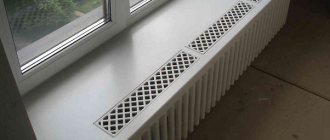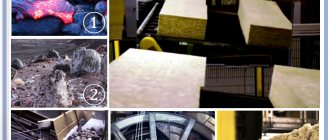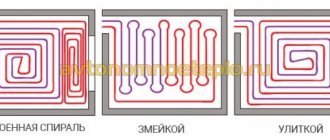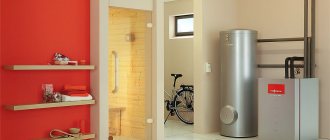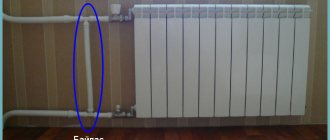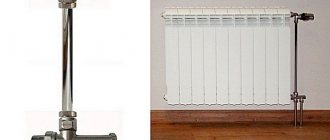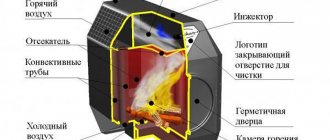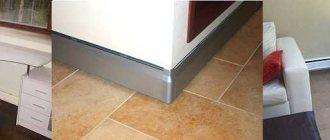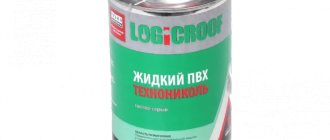Energy-saving heating PLEN: what it is, principles of operation
PLEN is a heating system based on the use of physical heat exchange processes. The effect is compared to the warmth of the sun. It has a multilayer structure.
Between two layers of lavsan films there is a special aluminum foil with a reflective surface, and between the layers of foil there are resistive elements. The thickness of film heaters is 1–1.2 mm.
Lavsan films perform two functions - electrical insulating and decorative . When the system is turned on, electric current flows to electric heaters that heat the foil, which reflects infrared waves with a length of 9.4 micrometers. These waves are invisible to the human eye, but are clearly noticeable as heat. As a result of heat exchange between the PLEN surface and the decorative covering (floor, ceiling or wall), heat spreads throughout the entire room.
The maximum temperature that electric heaters reach is 45 °C . Thanks to this, PLEN is considered one of the safest heating systems.
Film electric heaters serve as both primary heating and additional heating. Films can be installed on any flat surface , both horizontal and vertical and even inclined. Thanks to its features, PLEN maintains a feeling of warmth and comfort in the home.
Specifications
PLEN parameters are given in the table:
| Index | Characteristics | Declared data |
| Material | Heater | Special alloy |
| Insulation | Three-layer PET | |
| Reflector | Aluminum | |
| Weight | 1 m square | 550 g |
| Thickness | — | 0.4 mm |
| Temperature, max. | — | 45 °C |
| Power consumption | — | 150-175 W/m. square |
| Efficiency | — | 98% |
| Lifetime | — | >50 years |
Depending on the height of the room, the power is selected. This is due to the fact that part of the radiation is scattered in the air, as a result of which the heat rising from below will not reach the target. Manufacturers recommend using PLEN with a power of 125 W per square meter of up to 3 m . In other cases - 150 W per square meter.
Photo 1. Roll of film infrared electric heater. The material can be cut using ordinary scissors.
Operating principle of a film electric heater
When electric current passes through the heating element, heat is generated on it. It spreads by contact method along the transmission element (aluminum foil) to the surface of the heater (PET film). When heated, the surface of the heater begins to emit infrared waves in the mid-wave range: 8.6–9.2 microns.
Ranges of infrared radiation and corresponding temperatures in °C:
- near region: λ = 0.74–2.5 µm (from +3,650 to +877 °C);
- medium region: λ = 2.5–50 μm (from +877 to -215 °C);
- distant region: λ = 50–2000 µm (from -215 to -257 °C).
The dependence of the wavelength on the temperature of the heated body is calculated according to Wien's displacement law.
Electrical appliances for IR heating
The abbreviation PLEN means “film radiant electric heater” or simply “film electric heater”. It is permissible to use IR heating film as both an additional and the main source of heat.
In fact, it is a film with internal heating elements that emit infrared waves as a result of the passage of electric current through them.
Advantages of the infrared principle
Heating of air masses in a room from one source or another can be carried out due to:
- thermal conductivity;
- convection;
- thermal radiation.
The first two principles of heat transfer are used in water and oil radiators, as well as fans with heating coils.
In them, a certain working surface is first heated using a coolant or heating element, from which the room air is then heated in its immediate vicinity. Then, using natural or forced convection, air exchange occurs throughout the room.
Film IR heaters refer to heating systems that heat not directly the air in the room, but first the surfaces of the walls, pieces of furniture, floor and ceiling in it
Thermal radiation involves the transfer of heat from a source using electromagnetic radiation in the infrared spectrum. Air cannot be heated directly by infrared rays.
They can only heat surfaces made of solid materials. That is, first, as a result of the operation of the PLEN heating system, the furniture and decoration in the room are heated, and then they give off heat to the air.
IR rays are often called “thermal radiation” because the effect of infrared equipment is perceived tactilely by humans as a feeling of warmth and does not cause any discomfort.
Infrared heat is electromagnetic waves in the range of 0.74–2000 microns. If you look at the Sun, about 40% of its radiation to the Earth comes from visible light, and about 10% and 50%, respectively, from UV and IR rays.
IR-type film electric heaters generate thermal energy with a wavelength in the region of 9.2 microns. For humans, such rays are completely safe and natural, since they most closely resemble “sunlight.” After all, the human body itself emits heat in the infrared spectrum with a wavelength of 9.6 microns.
Film heating system design
IR film electric heaters include three main elements:
- heating;
- transmitting;
- radiate.
The first converts electrical energy into thermal energy. The second distributes the generated heat over the entire area of the PLEN, and the third emits infrared rays.
In addition to the heating IR film, the film heating system also includes a thermostat with one or more temperature sensors and cables for connecting the heater to the power supply.
The heating element in PLEN is made of a conductor with high resistance. Usually this is a thin strip of nichrome (spirals in heating elements are made from it) or carbon. At the same time, almost all manufacturers of film IR heaters have now switched to the second option. Carbon is more economical, cheaper and more efficient.
The transmitting element is a layer of aluminum foil, which has high thermal conductivity. It is located on one or both sides of the IR film. Also, a number of manufacturers do not use aluminum at all, relying only on the emitting material.
The top layer of the film heater in question on both sides is made of PET (polyethylene terephthalate). The film made from this thermoplastic has a high IR emissivity coefficient, can easily withstand temperatures up to +2000C and is an excellent dielectric.
The film cleans the internal heating elements from condensation and moisture, forms a single heating system from disparate components, and also reduces the risk of electric shock to almost zero.
The IR film is designed so that the heating elements inside it can only heat up to +55º C. Temperatures higher than this are practically excluded; such heating is only possible for a short time in an emergency situation with a sharp surge in voltage in the network
Calculation and installation of an IR film heater are made taking into account that the film will not heat continuously, but at short intervals from several seconds to several minutes.
That is, such an infrared heater quickly raises the temperature of the surfaces in the room to the required values, and then turns off the thermostat. And then it is again powered from the mains only from time to time as the room air cools.
General information about PLEN
PLEN – film radiant electric heater. In it, electrical energy is converted into infrared radiation, which heats the floor and, from it, the room. The system itself is multilayer, where there are non-conducting polymer films and resistors connected to each other.
This film is usually sold in rolls
When electrical energy passes through the resistors, they heat up and transfer heat to a highly conductive surface. It then transmits the received and converted thermal energy into infrared waves with a length of 9 to 12 microns. These rays heat another surface, which warms the room.
Principle of operation
After installing the system and connecting to electricity, the energy flowing through the resistors is converted into heat. This occurs through contact with an aluminum foil covering the entire film.
Schematic representation of PLEN heating
With proper distribution of resistor elements, the heat will be distributed evenly. When the surface heats up to a temperature of 40 - 45 ⁰C, infrared radiation appears, which moves to another surface, for example, the floor. Reflecting from it, it is evenly distributed throughout the room.
Recommendations when choosing a system
For ease of installation, films are available in different lengths and widths. The length varies from 1 to 5 meters , and the width is 35-65 cm .
The films are installed on approximately 80% of the ceiling surface. The area of the occupied floor depends on the amount of furniture. It is not advisable to install a heating system under upholstered and cabinet furniture, since natural heat exchange with the air will not occur.
also affect the efficiency of film heaters . If your home is located in a windy climate, you should choose a more powerful heating system, since heat loss will be significant in this case.
Important! Before installing the PLEN system, take care of the thermal insulation of the room. All surfaces should be insulated - floor, ceiling, walls, insulate windows and doors, and in a private house - the roof and basement. Otherwise, the operation of the PLEN will be associated with high energy costs.
Ceiling heaters
When installing infrared heating in this case, it is necessary to take into account the height of the suspension, most often it is 2.2-3.5 meters from the floor, it depends on the height of the ceilings. But it is not advisable to point such devices at a person’s area, especially where the head is located.
Ceiling infrared heater
You cannot hang the heater above the bed so that it is directed at the head; it is best to point it at the torso and legs. It is not advisable to install them near windows, as heat will be lost. It is also not recommended to install infrared heaters on PVC ceilings.
Scope of application of the PLEN heating system
The use of high-quality infrared emitters is harmless to human health, pets, and plants. It does not damage decorative coatings and functional parts of building structures. The absence of significant restrictions predetermines a wide scope of application.
PLEN heating is used to equip apartments and cottages, offices and kindergartens, public and industrial facilities. When installed in warehouses and other large premises, the emitters can be mounted only above workstations, in aisles. Rational placement of equipment will help create comfortable conditions without unnecessary installation and operating costs.
Taking into account good protection from adverse external influences, it is permissible to use PLEN heating in a wide range of humidity and temperatures. The exact boundaries are set in the manufacturer's accompanying documentation.
Important! When developing a system, official recommendations on the operating parameters of thermostats and other components should be taken into account. The required degree of security is checked taking into account IP classification standards.
The specially designed switch performs its functions reliably even in open spaces
Advantages of PLEN heating
According to consumer reviews, infrared heating has many more advantages than disadvantages.
Among the most significant advantages of the PLEN heater are the following:
- The resistor film does not burn oxygen during operation, unlike other electric heaters. The humidity level in the room remains at a stable level.
- By following all the rules and recommendations for the installation and operation of the PLEN, you can achieve its high-quality functioning for at least 30 years.
- As the system operates, there is usually no need for servicing.
- The profitability of PLEN is explained by the low level of electrical energy consumption. This allows the product to pay for itself in the first 1.5-2 years of use.
- This system is very mobile; it can be easily dismantled and installed in another area without involving specialists. This is facilitated by the light weight of the films.
- During operation of the film heater, components harmful to health are not released, which is why this type of heating is considered the most environmentally friendly. The device operates completely silently.
- To avoid electric shock if you accidentally touch the film, there is special protection.
- During operation of the PLEN, the possibility of fires is completely eliminated.
- Due to its small thickness, the installation of resistor film does not hide the space of the room.
- The parameters of electromagnetic waves emitted during operation of the device are within the permitted limits for use in residential premises.
- In the event of voltage surges or power outages, there is no threat of damage to the infrared heating.
- Thanks to infrared radiation, dampness and mold do not appear in the room.
- Heating with PLEN occurs very quickly; after a short period of time after switching on, surrounding objects become warm and begin to raise the air temperature.
- The minimum level of temperature maintained in the room is +10 degrees.
- The floor surface in a room equipped with infrared film is always warm, which significantly reduces the risk of colds.
- To install film heating, a complex system consisting of a boiler, piping, piping and radiators is not required. Already at the installation stage, very significant finances are saved.
- In the case of using PLEN as the main heating, it becomes possible to install an autonomous microclimate in each individual room. Such a system can be fully automated using programmable modes.
As for the disadvantages of PLEN infrared heaters, there are not many of them. It should be mentioned that in terms of efficiency, infrared films are about 1.5 times inferior to gas heating, while being much safer and more convenient to use. Before installing the system, ensure that there is a strong power supply.
Technical characteristics of PLEN heating
All film heaters of this type, produced by different manufacturers, are almost the same. The only differences are the dimensions: width and length. For example, the width has three standard sizes: 350, 510 and 650 mm. It should be added that the first two films have so-called “free areas” that do not participate in heating processes. They are located along the edges of the device. The latest model has three such areas: along the edges and in the middle. They are the assembly ones.
Fastening by mounting areas
And the technical characteristics of the PLEN heating itself:
| Characteristics | Heater PLEN |
| Supply voltage, V | 73, 110 and 220 |
| Specific power nominal/max., W/m² | 100/170 |
| Heating temperature, °C | 45÷50 |
| Emitted wavelength, µm | 9 |
| Current consumption power, A | 1 |
| Film thickness, mm | 1 |
| Heater weight, g/m² | 330 |
Attention! The length of the films varies in the range of 1÷5 m. That is, choosing the required size to install the device anywhere is not difficult. This is due to the fact that PLEN heaters cannot be cut, as could be done with warm infrared floors. Therefore, the advice is to first measure the length of the installation area, and then select IR films for it.
It is very important to understand that the standard size of PLEN devices and the consumed voltage are the main indicators that affect the heating power. How these values correlate, see the tables below.
Width PLEN
Film width 350 mm
| Length, mm | 1000 | 1000 | 1500 | 2000 | 2500 | 3000 | 3500 | 4000 | 4500 | 5000 |
| Voltage, V | 73 | 110 | 110 | 220 | 220 | 220 | 220 | 220 | 220 | 220 |
| Power, W | 60 | 60 | 89 | 119 | 149 | 179 | 208 | 238 | 268 | 298 |
Film width 510 mm
| Length, mm | 1000 | 1500 | 2000 | 2400 | 3000 | 3400 | 4000 | 4600 | 5000 |
| Voltage, V | 110 | 220 | 220 | 220 | 220 | 220 | 220 | 220 | 220 |
| Power, W | 87 | 130 | 173 | 208 | 260 | 295 | 347 | 399 | 434 |
Film width 650 mm
| Length, mm | 1000 | 1500 | 1900 | 2500 | 3000 | 3400 | 4000 | 4400 | 5000 |
| Voltage, V | 110 | 220 | 220 | 220 | 220 | 220 | 220 | 220 | 220 |
| Power, W | 111 | 166 | 210 | 276 | 332 | 376 | 442 | 486 | 552 |
From the data presented, it becomes clear how you can accurately select a PLEN system, taking into account not only dimensional indicators, but also taking into account power consumption, which affects electricity consumption.
Rules for installing film heating
Connecting the film to the thermostat
The installation largely depends on the technical characteristics of the PLEN heating system. First of all, the overall dimensions of the roll. To carry out this work, you do not need to involve specialists - all stages of installation are carried out without special tools. It is important to configure the system correctly.
Most reviews about the PLEN heating system refer to the operation of this type of heat supply. And only a small number indicates possible installation difficulties. They are related to the primary condition of the installation surface and the location of electrical wiring in the house.
Knowing the definition and features of PLEN heating, general recommendations for its installation were developed. They are as follows:
- Choosing a mounting location . This could be the floor, walls or ceiling. The latter option is preferable, since PLEN infrared heating should cover as much of the room as possible. Ideally, the area is between 60 and 75% of the total surface.
- Preparing the rough ceiling . In many videos about PLEN heating, little attention is paid to this point. But for proper operation it is necessary to ensure a perfectly flat surface. To do this, make a mounting grid from a galvanized profile or wooden slats.
- Preliminary insulation and waterproofing . This is necessary to ensure safe and long-term operation of PLEN infrared heating.
- Drawing up an installation diagram . It indicates the location of the film, connection and installation of control elements.
Installation of IR film
Only after these steps can you install PLEN heating yourself. The distance between the films should be at least 10-12 cm, and their distance from the walls is 4-5 cm. Considering that the PLEN ceiling heat supply is sensitive to the resistive effect, additional insulation is installed in the places where the electrical wiring passes.
If installation is carried out on the floor, you need to take into account the technical and operational parameters of PLEN heating. Upon completion of installation, a concrete screed must be poured. In this case, it is necessary to trace the location of the films - during the process of pouring concrete, they should not move under the mechanical action of the mixture.
With a large heating coverage, PLEN provide for the installation of several control thermostats and temperature sensors.
Nuances of the installation process
It should be noted right away that the PLEN heating system is installed on foil insulation, which will not only create a thermal insulation layer, but also reflect emitted waves towards the room using foil. Therefore, the surface on which the heating film will be mounted must be covered, for example, with isolon.
Izolon must be placed under PLEN
Now, regarding the mounting of the heater itself. Everything will depend on what material it will be attached to.
- If it is wood, then the best option is metal staples and a stapler. In this case, you can use nails or wood screws.
- If it is concrete, then you will have to drill holes in it, insert plastic dowels into them, and screw screws into them through the film.
As for the principle of laying the film, first of all you need to decide in which direction the connection to the current supply will be located. The shorter the distance between the connection points, the less cables you will have to use for wiring. And this is savings.
Depending on the chosen model and size of the heater, its coverage area is determined. This indicator varies between 50÷100%, but 80% is considered optimal.
Connection nuances
Depending on which voltage devices were selected, their own circuits are used:
- If films with a voltage of 220 V are selected, then they are connected to each other only in parallel.
- If 110 V devices are used with a connection to a 220 V network, then they are connected to each other in pairs. The latter are connected to each other in parallel.
- The same is with PLEN heaters with a voltage of 73 V. They are connected to each other in series, 3 pieces at a time.
Connection diagram for film electric heater
The film electric heater operates from a 220 V, 50 Hz power supply. Connection – parallel . Connection of heaters with two terminals is made according to a two-wire circuit : Phase L, Zero N. See fig. for the wiring diagram. below.
Connection of a film electric heater with 3 or more terminals is also carried out using a two-wire circuit, but taking into account the factory marking of the terminals : Phase L, Zero N, fig. below.
If the heater has a ground (for example, ZEBRA EVO-300), then the connection is made in parallel using a three-wire circuit : Phase L, Zero N, ground PE.
Advantages and disadvantages
Pros:
- a heating system based on thin films is definitely the most compact, because it takes up almost no space indoors and can be placed there as part of a wall, floor or ceiling;
- significant savings on installation, which does not require huge investments at once, because such a system can be assembled gradually from room to room, and it will start working immediately;
- no costs for maintenance or replacement of worn parts;
- ensuring a comfortable indoor microclimate by maintaining optimal air humidity, but dry air is the scourge of most heating systems, so PLEN is an exception and does not disturb the microclimate of the house;
- simplicity and ease of installation, which does not require any special knowledge and experience, or additional assistance, because thanks to the lightness of the elements, such a structure can be installed absolutely independently and in a short time;
- the minimal inertia of such a heating system, in contrast to standard heating structures, makes it possible to configure an individual microclimate in each individual room of the house;
- such systems are assembled from environmentally friendly materials and retain their properties throughout their entire service life, without releasing any chemicals into the environment;
- meets the highest fire safety requirements, since even the resistors themselves have a maximum temperature limit of 50 degrees, which is safe both for them and for objects and people in contact with them;
- one of the longest warranty periods among all heating systems - more than 10 years.
Minuses:
- finishing of such a film is possible with any decorating materials that do not have metal, but the whole point of this system is the maximum area of contact of the heating elements with the surrounding space, which means that with any decoration it will lose efficiency;
- an uncovered film does not have the best aesthetic appearance, and requires decoration with at least lattice structures that do not block infrared radiation.
Myths of manufacturers and sellers about film electric heaters
Myths about film electric heaters are harmful misconceptions that multiply nonsense. These myths are found on the websites of manufacturers and their dealers. The main goal of such myths is to attract clients and denigrate a competitor. They do not provide any useful information from a practical point of view. Moreover, there are such absurd ones that they defy logical explanation.
Myth 1. Deviation of the resistor by several microns from the original parameters leads to a sharp increase in energy consumption
A resistor is a heating element in a film heater design. Deviation of the linear dimensions of the resistor from the original parameters will lead to a change in its resistivity:
- The cross-sectional area of the resistor is larger - the specific resistance is lower, the power of the electric heater increases .
- The cross-sectional area of the resistor is smaller - the resistivity is greater, the power of the electric heater decreases .
The energy consumption of a film heater as a heating system depends on:
- On the degree of insulation of the building envelope. The better the room is insulated (building insulation from 100 mm or more), the less heat loss it has. And, conversely, with poor insulation of the room, heat losses are greater.
- From the temperature conditions inside and outside the room.
The two points above are the main parameters on which the energy consumption of a film electric heater depends.
The main task of the heating system is to replenish the heat losses of the room . The heating ceiling system operates in automatic mode (control is set by a thermostat). It is the thermostat that determines the frequency of turning on and off the heating system, depending on the desired air temperature set on it and the two parameters outlined above.
The question arises. How can the statement in myth No. 1 (a deviation of the resistor by several microns from the initial parameters entail a sharp increase in energy consumption) lead to a change in the main parameters of the energy consumption of a heating system using film electric heaters? None! The myth is destroyed .
Myth 2. The film heater operates in the long-wave infrared range, which has a beneficial effect on the human body
The long-wave range of infrared radiation (far region) is in the range 50-2000 microns , which corresponds to temperatures from minus 215 to minus 257 ° C. If the temperature in your house is -257 °C, then with such “non-existent” heaters you can heat the room to -215 °C. The question arises. How can these negative temperatures have a beneficial effect on the human body?
The film electric heater operates in the mid-wave range (middle region) of infrared radiation. The infrared wavelength is 8.6-9.2 microns , which corresponds to temperatures of +60 , +40 ° C. The myth is destroyed .
Myth 3. The fire safety of a film electric heater is 100%
100% fire safety of a film electric heater is a 100% marketing ploy of the manufacturers. Ceiling or floor heating film material is an electrical appliance. The operating modes of an electrical appliance are normal and emergency.
Operating modes of the electrical appliance
Normal operating mode of the electric heater . This is the operating mode of an electrical appliance in accordance with the technical parameters stated in the manufacturer’s passport (rated voltage, current, power).
In normal mode, ceiling film heaters will heat up to no more than +50 °C. According to the stated technical characteristics, the heater will not be able to heat up any more. The electrical appliance does not overheat, short-circuit, or spontaneously ignite.
Emergency operation of the electric heater . Possible when there is a malfunction of the electrical appliance itself or the electrical network. For example: poor-quality connection during the manufacture of a film electric heater, mechanical damage to an electrical appliance, errors in installation technology, power surges, natural disasters - thunderstorms.
In emergency mode, there is a risk of overheating of the electrical appliance. The surface temperature of the film heater can reach +100 °C or more. The insulating layer (PET film) begins to deteriorate, which can lead to a short circuit and further spontaneous combustion. The combustible material in the film heater is PET film. An electrical appliance made of PET film cannot be 100% fireproof. The myth is destroyed .
We do not sell 100% fireproof film electric heaters as they do not currently exist. But we offer the highest quality and most protected of them. the ZEBRA EVO-300 heater has the highest fire safety ratings . Its parameters:
- G1 – means slightly flammable, GOST 30244.
- B1 – flame-retardant, GOST 30402.
- D2 – exhibits moderate smoke-forming ability, GOST 12.1.044.
- T2 – moderately emits toxic combustion products, GOST 12.1.044.
- RP1 – practically does not spread the flame, GOST R 51032.
Myth 4. Aluminum foil in a film electric heater is a reflector or emitter of infrared waves
Aluminum foil does have a high reflectivity of infrared waves , but only if it is a finite surface . In a film heater design, aluminum foil is not the final surface. The final surface in the heater is PET film , so the reflective properties of aluminum foil do not work in a film electric heater.
Aluminum foil in film electric heaters is necessary to transfer thermal energy evenly and over the entire area of the heater. The foil, along with its high reflectivity, has a low emissivity of infrared waves (0.04) . It is technically irrational to use foil as an emitter of infrared waves.
It is this physical property of aluminum foil that the manufacturer of the ZEBRA EVO-300 heater uses for one-sided thermal radiation .
In the design of ceiling heaters (heating film TM, ZEBRA EVO-300, etc.), the emitting surface of infrared waves is PET film (polyethylene terephthalate). It is a material with a high emissivity of infrared waves: 0.8 . The myth is destroyed .
Myth 5. Our company’s film heater has no analogues in the world
To understand this myth, you need to understand what an analogue is. Analogue - an object or technical solution of the same purpose, similar in terms of the totality of essential features.
All film electric heaters have the same purpose - low-temperature heating in various applications (heating system, heated ceiling, heated floor, drying wood, drying vegetables and fruits, etc.). And they all have similar essential features:
- operate from a power supply of 220 V, 50 Hz;
- the operating principle is based on the Joule-Lenz law;
- the emitting surface is PET film;
- low temperature operating mode.
Even our Sun has analogues in the form of billions of other stars in the Universe. And unscrupulous manufacturers and sellers assure that their product has no analogues! Therefore, beware of those who claim that their products have no analogues! The myth is destroyed .
You can buy film electric heaters and components at a profit in our online store.
Specifications
Resistors in such a heating system are made of special alloys that provide good heat transfer and long service life. Their insulation is made of three layers of PET. Aluminum is used as the reflector material. Weight of a panel with an area of one square. meter is about 550 g, its thickness is from 0.4 to 1.0 mm.
Peak operating temperature 50 degrees Celsius. The power consumption of one panel is from 150 to 175 W. The efficiency is close to 98%, and the service life is more than half a century.
Heating panels are produced with different densities, and therefore power: from 100 to 150 W/m2. A film of higher density has a larger number of heating elements and is capable of heating rooms of a larger area, which in this case is determined by the height of the ceiling, since some of the radiation from the device, scattering in the space of the room, may not warm its entire area.
Additional opinions on benefits
The film electric heater has many positive features, among which we should also highlight ease of installation. Consumers emphasize that, if necessary, it will also be possible to dismantle the structure. Infrared film does not take up useful space; it can be laid under any ceiling covering, except metal.
After dismantling, the system will retain all its properties and can be installed in another location. Buyers emphasize that PLEN allows the use of highly efficient heating, which is safe. The rooms warm up very quickly after turning on the system. In an hour the temperature rises by 15 °C, and it is easy to regulate.
The efficiency factor, as emphasized by buyers who have already enjoyed the quality of the film described, reaches 95%. Infrared heating is fireproof and equipped with protection against electric shock. The device is not afraid of voltage surges and temporary power outages.
Types of PLEN systems according to the method of placing heaters
In fact, film IR heaters can be installed on any more or less flat, straight surface. But most often they are placed on the ceiling or under the floor covering. Wall mounting is an extremely ineffective solution and can only be dictated by the technical need to heat a specific location. The same elements, methods of fastening and connecting them are used for both the floor and the ceiling.
Ceiling systems
When PLEN panels are placed on the ceiling, the IR radiation will be directed straight down. Thus, the main absorption area will be on the floor, which will act as the main element that accumulates and then releases heat. In accordance with the law of convective heat exchange, the air heated by the floor surface will rise upward. At the same time, the temperature at a height of 1.5 m will be 1.5÷2°C lower than on the floor surface. This temperature distribution is considered optimal from a medical point of view. An additional advantage of ceiling placement is the ability to install any type of decorative covering: plasterboard, lining or suspended ceilings, provided they are placed at some distance from the heating element.
Complete heating of the attic space using infrared film PLEN systems installed both on the ceiling and on the walls
For film placed on the ceiling, the risk of mechanical damage is significantly reduced. However, if ceiling infrared heating is located in an apartment in a multi-storey building, you should take care of reliable waterproofing as protection against flooding by neighbors above. There are also certain technical limitations; installing film IR heaters is not economically feasible if the ceiling height in the room exceeds 3.5 m.
Floor systems
Almost any materials can be used as flooring: laminate, parquet, carpet, some types of linoleum. When choosing them, you should pay attention to the mark. After switching on, IR radiation is absorbed by the flooring material, which, after heating, transfers heat to interior items. In fact, regardless of the installation location of the heating elements, the heating of the room is carried out by convection. The main advantage of the floor arrangement is the lack of exposure to infrared rays on residents and household appliances.
Warm floors are completely safe and can be used in rooms with moderate humidity
Important! Neither manufacturers of household appliances nor laboratories testing them have provided convincing evidence of the negative impact of infrared radiation on modern consumer electronic devices. However, many users are confident that IR waves are the reason for the rapid failure of household equipment.
The resistance to mechanical stress and humidity of some brands of PLEN panels is high enough for them to be used for heating the soil of greenhouses
Advantages and disadvantages of the PLEN system
Anyone who would like to install PLEN in their home is interested in learning about the advantages and disadvantages of the system.
Let's start with the advantages of installing it:
- Economical. Compared to other types of electric heating, energy costs are on average one third less. There are no operating costs required.
- Reliability and durability. Conductors sealed in film can last indefinitely. There are no moving or wearing parts in the design.
- Compact placement. Film heaters can be installed under any covering. They don't take up a lot of free space.
- System automation. This makes it possible to regulate the temperature in heated rooms and save energy.
- Versatility. The breakdown of one of the PLEN fragments does not disable the entire heating coating.
- Favorable effect on the microclimate. When the system is operating, the amount of oxygen and air humidity in the room do not change. Heat is distributed in an optimal way for a person.
In addition, you need to know that PLEN operates absolutely silently, without convection currents from air and dust. The efficiency of the system reaches almost 100%, there is no heat loss. The service life of the equipment is calculated in decades.
Most manufacturers provide a 25-year warranty, emphasizing that the system has a service life of at least 50 years. During the entire service life, film heaters do not require maintenance.
One of the advantages of the PLEN system is its compact placement. It can be easily hidden under almost any type of floor or ceiling covering
The system also has disadvantages. First of all, its installation will require sufficient electrical power and fully functional electrical wiring. Which is not always possible, especially when it comes to old houses.
In this case, you will most likely need to install new wiring, which is an additional cost. When the network voltage drops, the amount of heat generated by the film heater decreases.
True, this will not affect the room temperature in any way, since the operating time of the equipment will automatically increase. But it will affect your electricity bills.
Sometimes film heaters are fixed to the ceiling or walls without any additional finishing. It is not right. The foil on which the resistive elements are attached has high reflectivity.
The foil with resistive elements attached to it shines, which causes visual discomfort. It is recommended to cover it with a decorative coating
This causes visual discomfort and is simply not aesthetically pleasing. Therefore, it is advisable to cover the PLEN with some kind of finishing. At the same time, you need to know that it will not work to hang wallpaper, for example, on top of a film heater.
It also cannot be painted or puttied. It is best to use any decorative covering that will need to be installed above the equipment.
Installation of PLEN
Manufacturers stated that radiant heater films can be installed on any surface. However, traditionally they are mounted to the floor or ceiling.
Important! Before installing the heating system, it is necessary to install a thermal insulation layer , since otherwise the floors will warm up, which will lead to unnecessary heat loss. The thermal insulation layer can be anything, preferably with a reflective surface.
The films are attached directly to the thermal insulation layer or to the sheathing. Self-tapping screws or a construction stapler are used for fastening.
Installation location
A lot depends on the choice of installation location. Particular attention should be paid to places near door and window openings , since this is where large heat losses occur. Depending on the climatic conditions of residence, the area occupied by the PLEN is determined.
In temperate climates, about 60% . If the climate is cold and windy, then the area should be at least 80% . Ideally, PLEN plays a complementary role in such a climate. In warm climates, it is enough to allocate no more than 50% of the room area for a film heating system.
Preparation
Before installing the heating system, you must carefully check the integrity of all elements.
The condition of the outer layer of films is visually determined. It should not have scratches or breaks.
The integrity of the heating elements is checked using a tester . As a rule, there are no defective items on sale, but during transportation, in particular to the installation site, various incidents could occur.
Installation process
Before installation, make sure that all wires exit on one side and are directed towards the distribution panel. Each sheet of the heating system has special installation zones.
Attention! The sheets are fastened precisely in these fields. It is impossible to violate the integrity of PLEN sheets outside the installation areas, as this is fraught with unpleasant consequences.
Before installing the system, stock up on tools and materials. You will need:
- PLEN sheets;
- construction stapler or self-tapping screws;
- aluminum tape;
- stationery knife;
- soldering iron;
- thermal insulation.
A heat-insulating layer with a reflective surface is first attached to a properly prepared installation site. Thermal insulation sheets fit tightly together. The joints between them are carefully taped with aluminum tape.
Reference. Cut the insulation sheets into as large pieces as possible. This will eliminate a large number of joints and, as a result, large heat losses.
Within the installation zones, PLEN sheets are attached to the heat-insulating layer using a construction stapler or self-tapping screws. The step between the brackets is about 0.3 m. The wires should come out on one side.
Photo 3. Installation of infrared electric heaters. The cables are secured using special tape.
When the entire planned area is covered with sheets of the heating system, the wires between the individual sheets are soldered together. To insulate the soldering point, use ordinary electrical tape or a piece of insulation from a thick cable. In the second case, the insulation is heated to ensure a tight fit.
What is PLEN and how does it work?
PLEN stands for “film radiant electric heater.” This is an infrared heating system consisting of a resistive radiating element located between polymer films. The basis of the PLEN system is the interaction of infrared radiation with various matter and its physical properties.
It is called a resistive element because it consists of several layers of resistor circuits (resistances).
When PLEN heating is connected to the electrical network, an electric current begins to pass through the resistors, and they heat up to a fairly high temperature - 40-50°C. At the same time, the material from which the resistors are made can emit infrared radiation. And in order for it to be used to heat the room, before laying the PLEN, foil is placed on the side of the ceiling, walls, floor or other surface, which reflects the directed rays.
The heating time of the resistor film takes less than 10% of the time required to warm up the entire room. Within 1-2 hours, the temperature increases by 10 degrees - this is the minimum interval. Then the PLEN heating system continues to maintain the set temperature and turns on periodically for 3-15 minutes every hour.
Even the best heater will not work properly if it is not managed correctly.
The PLEN heating system, as a rule, consists of a heater and a control unit. The required temperature is set using a thermostat. The thermostat installed in the room itself monitors the temperature surrounding it using a built-in temperature sensor and controls a special unit according to the difference between the actual and set values it detects.
In addition, if the room is properly insulated, then PLEN consumes less electricity.
Tips for choosing
In order not to be disappointed in the IR heater, you should treat the purchase of this device responsibly and calculate everything in advance. Please evaluate the following criteria carefully.
- Possibility of heating using other, cheaper options. For example, it is not entirely reasonable to install an electric heater where there is gas. The latter option is still more economical. If gas is not available, then PLEN will be a good option.
- How much time do you plan to spend indoors? If you are considering the option of heating using a film heater in a country house where people do not live all year round, then you can make a choice in favor of decorative panels or IR paintings. Installing a full-fledged ceiling or floor system in such a room is impractical due to its high cost, as well as labor-intensive installation.
- PLEN shows itself most fully in concrete and brick houses, but in buildings made of other materials alternative options can compete with them.
- Before purchasing, you must check all certificates for the heaters you purchase. Unfortunately, not all sellers sell goods of adequate quality. Therefore, it makes sense to purchase products only from proven and reliable companies.
Guided by these tips, you can choose the best option for PLEN and save not only money, but also installation time.
Operating principle of PLEN
The Russian stove is an ideal source of radiant heat. However, such a bulky structure cannot be built in every room. For this purpose, compact and efficient film electric heaters “Zebra” were invented, which were developed by Chelyabinsk electrical engineers.
As already indicated, the design of PLEN is as simple as possible. It is a resistive radiating element laid on a foil substrate, which is laminated into a durable film. The total thickness of such a heater is approximately 1.5 mm. Length and width are not limited.
A multilayer resistor circuit is used as a resistive component in the design. When the heater is turned on, power is supplied to the contacts of the resistors to heat them up. The product quickly heats up to 45-40 C. This is quite enough for the resistors to begin to emit long-wave infrared radiation. It is dispersed throughout the room extremely evenly and is smoothly absorbed by various opaque objects.
They, in turn, heat up during the absorption of IR waves and release heat into the air. It will take 1-1.5 hours for the room temperature to increase by ten degrees. What matters is the degree of thermal insulation of the building and the accuracy of the installation of the film heater. If during installation work a substrate reflecting infrared waves was not placed under it, it will work less efficiently.
After the temperature in the room has reached the set value, the thermostat turns on, which turns off the heater. After the room has cooled down a little, it will work again and start the heater to work. Thus, PLEN does not operate constantly, but only in periods, which makes it very economical. The quality of heating does not suffer at all: the room is maintained at the set temperature.
The devices are produced in the form of strips, the length of which is determined by the manufacturer. As a rule, it varies between 5-6 meters. For ease of assembly inside the strip, the device is divided into parts that can be cut off without losing the functionality of the entire system. The width of the canvases also varies. Usually you can find options with a width of 0.5 or 1 meter, like the Zebra film.
Cost of heating equipment PLEN – where to buy, prices, catalogs, manufacturers
Manufacturer/Name Radiation power, W/ sq. m. Price, rub./ sq. m. Notes
| "Luch"/PLEN | 120-150 | 1200-1400 | Typical design: resistor, aluminum, Mylar film. |
| "PSO"/Zebra EVO-300 | 220-225 | 1250-1440 | Sections with dimensions of 0.5 x 0.6 m. It is permissible to connect elements to form a field of the desired configuration |
| "ESB-Technologies"/PLEN | 150 and 175 depending on modification | 1150-1300 | The manufacturer offers several options with protection according to IP classes: 44, 54 and 67. |
When choosing PLEN heating, technical characteristics, purchase price, cost of additional equipment and installation are considered as a whole. This approach minimizes errors. Use the comments to the article to obtain additional information, experience, and your own reviews of products from different manufacturers.
Self-installation of heating PLEN. Reviews from real owners
Film infrared heating of the house, prices for the material were discussed above, you can install it yourself. To do this, prepare the surface to which you will attach, and then do the following.
| Work stage | Photo example |
| After cleaning the surface, it is necessary to create conditions so that the IR radiation goes in the desired direction. Cover the surface with foil or insulation with such material on one side. This should be done with an overlap of 2-3 cm. | |
| It is recommended to secure PLEN strips with a stapler. Leave a gap between the strips with a distance of up to 20 cm. Make sure the system is tight. | |
| The cable to which you will attach the heaters should be routed directly next to the panels. In this case, the wiring must run parallel to the main cable. | |
| Choose a suitable location for the thermostat, which is usually placed at a height of no more than 1.7 m in an open access area. | |
| Before carrying out finishing work, check whether the PLEN heating system is functioning correctly. |
Whether it is worth buying PLEN heating, the price of which is quite high, is up to you to decide. To make it easier to carry out installation work yourself, watch the video on the topic.
Installation of PLEN under suspended ceilings (video)
Consumer Reviews
When choosing heating systems, PLEN heating is also considered. The technical characteristics and price were discussed earlier, but the last aspect remains - reviews from the owners of such heat.
Dmitry, Ryazan: “I have a small one-story private house. A gas boiler, according to my calculations, was too expensive, and PLEN was recommended. I installed it myself a year ago. I did it quickly, but at first I didn’t get the finishing right and lost half the heat along the way. I remade it after 2 months, greatly regretting that I got involved with film heating. But after the correct selection of finishing material for the ceiling, all the problems went away, it was easy to set the temperature in the rooms and it was very convenient to use the equipment.”
Example in a wooden structure
Maria, Tula: “I ordered the finishing along with the installation of a heating system from one company in our city. The employees annoyingly advertised PLEN, and I gave up. Honestly, when I first saw the ceilings, I was shocked. Office type and nothing what I wanted. But with the arrival of winter, I felt all the delights of this type of heating and now I myself recommend it to my friends.”
Related article:
Infrared heaters for heating rooms. IR heaters are very common today. Let's consider the features of their designs, as well as areas of application.
Some notes and recommendations for use
- One should not expect high efficiency from film IR heaters, as well as from any other heating units, in the absence of thermal insulation of the housing enclosing structures.
- Marketers' statements about the PLEN wavelength of 8 microns, supposedly optimal for human perception, do not correspond to reality - the radiation of IR heaters is always in a certain range and cannot consist of waves of any one length.
- Installing PLEN in one room, even over the entire area of the enclosing structures, will not solve the problem of heating other rooms for the house.
- The operation of PLEN is not accompanied by a decrease in oxygen in the room air, so there is no need to increase the frequency of room ventilation when using film heaters.
- It is not necessary to turn off the PLEN system in the summer - just set the thermostat to the desired temperature value.
- The durability of infrared film heaters declared by manufacturers (up to 50 years) is a hypothetical value, since PLENs began to be produced relatively recently.
- The safety requirements for household electrical appliances, including film-type ones, are set out in GOST R 52161.2.96-2006.
Connection recommendations
Infrared ceiling systems are connected in accordance with the recommendations provided by the manufacturer. It is better to entrust this part of the work to experienced electricians, because they will be the ones who will be able to calculate the cable cross-section taking into account the total power. It is important to carry out the correct wiring.
The blades are connected to the network in parallel, while the thermostat must go out of phase. Looking at the table with film sizes, you can see that there are samples for 73 or 110 V. Their sizes are small, and such films are intended for narrow and complex areas where a large canvas will not fit. In this case, the connection is carried out taking into account some nuances.
For example, a pair of 110-volt blades are connected to each other in series. If you plan to use 73-volt blades, then there should be three of them in a series circuit. The thermostat is installed in an open circuit only if the total load current does not exceed 9 A. If only higher, then it is recommended to use a different connection scheme, which involves the use of a special device - a modular contactor. Its main task is to level a heavy load, because a thermostat is a precise and thin device that does not need overheating. Contact connections are made by soldering with double-layer insulation using a heat-shrinkable tube.
The influence of infrared radiation from PLEN heating on human health
High-quality devices of this type generate waves with a length of more than 9 microns. This radiation is completely safe for humans. It is not able to penetrate deep into the skin. It cannot be used for tanning. Relevant certifications confirm the possibility of using PLEN heating in medical institutions, schools, universities, kindergartens, and residential buildings.
For your information! With high-quality insulation of the room, the film emitter operates for 4-10 minutes per hour (after the air temperature rises to the operating value).
What is PLEN?
What is PLEN made of?
As the name implies, PLEN is a film material for heating. And it is in the design of this high-tech film that the main secret lies. The fact is that this film is multi-layered and each layer performs its own function. The base consists of three lavsan layers, which simultaneously serve as protection for the internal, radiating layers. The inner layers of the PLEN heating system are resistive elements, or, more simply put, a wire that heats up when an electric current passes through it and emits infrared waves, as well as a special foil that heats up from resistors and shields heat. All this is firmly laminated between lavsan layers and the total thickness of this “sandwich” does not exceed 1.5 mm.
Operating principle of IR heating
Heat distribution diagram for IR heating
All infrared heating devices are based on a single principle - long-wave radiation in the infrared spectrum. In this case, the glow can either be completely absent or be very insignificant, since the main purpose is to heat, not illuminate. The infrared rays of the equipment are identical to those that our planet receives as part of the solar radiation spectrum and are selected taking into account the greatest comfort for humans. The PLEN heating system in this sense is no different from panel or pendant-type IR heaters. The radiation is distributed in the room in the desired direction using a special reflector. Only in the case of film coating, less importance is attached to focusing and a larger area of heat distribution. That is, film heaters are designed to heat as large an area as possible with minimal dimensions.
Technical characteristics of PLEN
The PLEN roll cannot be connected to the network when rolled up.
Film electric heaters are supplied in rolls. Module sizes range from 1 to 5 m and widths from 0.35 to 0.65 m. Thus, it is not difficult to select the required number of modules to cover a room of any configuration. The thickness of the coating varies from 0.55 mm to 1.5 mm among different manufacturers. Weight 1 sq. m PLEN – 500-700 g. Radiation wavelength – about 10 microns. The voltage used for connection is 220 V. The current consumption is 1-1.2 A. The system efficiency is in the range of 89-94%. However, the energy consumption of PLEN systems largely depends on how well the room is insulated. Consequently, the better you take care of reducing heat loss, the lower the financial costs of heating your home will be.
Warranty periods for infrared PLEN heating also vary between different suppliers. The minimum is -10 years, and the maximum is 50.
